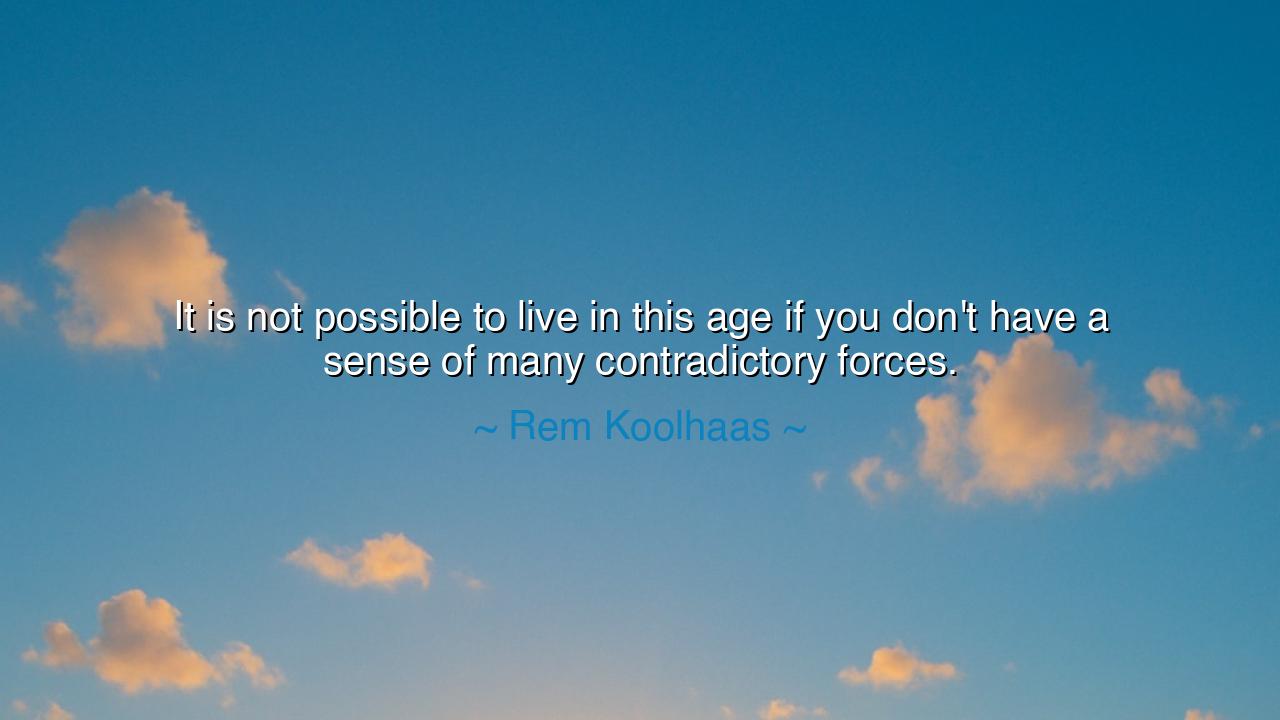
It is not possible to live in this age if you don't have a sense
It is not possible to live in this age if you don't have a sense of many contradictory forces.






In the complexities of the modern world, where forces pull us in every direction and contradictions seem to define our every experience, Rem Koolhaas offers a truth that resonates deeply: "It is not possible to live in this age if you don't have a sense of many contradictory forces." His words speak to the heart of our modern condition, where the push and pull of opposing forces shape not only our society but our very identities. The contradictions of the age—the clash between tradition and innovation, wealth and poverty, progress and decay—are not anomalies, but essential features of the world in which we live. To navigate this world, one must develop the ability to recognize and understand these contradictory forces, for they are the essence of the era itself.
The ancients also grappled with the idea of contradictions in their world, although they often sought to resolve them in the pursuit of harmony. In Plato’s Republic, he explored the nature of justice, which he viewed as a balance between the various parts of the soul, each representing a different force. For Plato, the ideal society was one where these forces—reason, spirit, and desire—were harmonized to create a just whole. Yet, even in Plato’s time, these forces were not always in perfect alignment, and society’s struggle with contradiction was ongoing. The ancients were keenly aware that life is composed of opposites, and the balance between them, rather than their eradication, is what allows for growth and progress.
Consider the life of Heraclitus, the philosopher who famously declared, “Everything flows,” and taught that change and opposition were fundamental aspects of existence. Heraclitus believed that the world was in a constant state of flux, driven by the interaction of contradictory forces—fire and water, day and night, life and death. Just as Koolhaas suggests, living in such a world requires an understanding that contradiction is not something to be feared, but something to be embraced. It is through the tension between opposing forces that the world evolves, just as the tension in a bowstring allows the arrow to fly true.
The story of the Renaissance provides another example of how contradictory forces shape human progress. During this time, Europe saw a profound clash between faith and reason, between the church’s authority and the rise of humanism. Figures like Leonardo da Vinci embodied these contradictions in their work, blending art and science, faith and empiricism. Da Vinci’s genius was in his ability to navigate the tension between these forces, seeing them not as enemies but as complementary aspects of a larger truth. The Renaissance, though born out of the clash between old and new ideas, became a period of extraordinary growth precisely because it embraced the contradictions of its time.
In more recent history, Mahatma Gandhi and his struggle for India’s independence present another example of navigating contradictory forces. Gandhi’s philosophy of nonviolence was itself a contradiction in the face of colonial oppression, where the forces of violence and subjugation seemed insurmountable. Yet, Gandhi’s brilliance lay in his ability to synthesize these opposing forces, using the moral power of nonviolence to resist the physical violence of the British Empire. His method was not to ignore the forces of oppression, but to confront them with an equally powerful but opposing force: peace. Through this, he proved that contradiction can be a tool for transformation when understood and wielded with intention.
Koolhaas speaks not just to the struggles of the present age but to the human condition itself: that the essence of life is in its contradictions. As ancient wisdom teaches, balance does not come from eliminating opposing forces but from finding a way to live with them, to understand their roles in the grand design. Just as Heraclitus observed the constant dance of opposites, and Gandhi merged resistance with peace, we too must learn to navigate the contradictions that define our age.
The lesson of Koolhaas’s words is that the key to thriving in our modern world is not to reject the contradictions we face but to accept and understand them. Whether in politics, technology, culture, or personal growth, we must become adept at holding opposing forces within ourselves and within the world around us. Only then can we move forward, creating new paths of innovation and progress. Rather than being consumed by the tension, we must learn to use it as a force for positive change, much as Leonardo da Vinci used the tensions between his art and science to shape a legacy that continues to inspire.
Thus, let us heed Koolhaas’s call and not shy away from the contradictory forces that shape our world. Instead, let us engage with them, finding meaning and purpose in the very tension that drives growth. As the ancients taught, balance does not lie in eliminating opposites, but in understanding their roles, in weaving them into a cohesive whole. In doing so, we align ourselves with the true spirit of the age—one that embraces both chaos and order, change and tradition, and uses the interplay of these forces to move toward a future of limitless potential.






AAdministratorAdministrator
Welcome, honored guests. Please leave a comment, we will respond soon